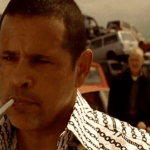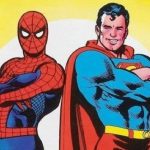 Technology
Technology  Technology
Technology  Humans
Humans 10 Everyday Human Behaviors That Are Actually Survival Instincts
 Animals
Animals 10 Animals That Humiliated and Harmed Historical Leaders
 History
History 10 Most Influential Protests in Modern History
 Creepy
Creepy 10 More Representations of Death from Myth, Legend, and Folktale
 Technology
Technology 10 Scientific Breakthroughs of 2025 That’ll Change Everything
 Our World
Our World 10 Ways Icelandic Culture Makes Other Countries Look Boring
 Misconceptions
Misconceptions 10 Common Misconceptions About the Victorian Era
 Mysteries
Mysteries 10 Strange Unexplained Mysteries of 2025
 Miscellaneous
Miscellaneous 10 of History’s Most Bell-Ringing Finishing Moves
 Technology
Technology Top 10 Everyday Tech Buzzwords That Hide a Darker Past
 Humans
Humans 10 Everyday Human Behaviors That Are Actually Survival Instincts
 Animals
Animals 10 Animals That Humiliated and Harmed Historical Leaders
Who's Behind Listverse?

Jamie Frater
Head Editor
Jamie founded Listverse due to an insatiable desire to share fascinating, obscure, and bizarre facts. He has been a guest speaker on numerous national radio and television stations and is a five time published author.
More About Us History
History 10 Most Influential Protests in Modern History
 Creepy
Creepy 10 More Representations of Death from Myth, Legend, and Folktale
 Technology
Technology 10 Scientific Breakthroughs of 2025 That’ll Change Everything
 Our World
Our World 10 Ways Icelandic Culture Makes Other Countries Look Boring
 Misconceptions
Misconceptions 10 Common Misconceptions About the Victorian Era
 Mysteries
Mysteries 10 Strange Unexplained Mysteries of 2025
 Miscellaneous
Miscellaneous 10 of History’s Most Bell-Ringing Finishing Moves
10 Characters Killed Off Because the Actor Died
Actors are among the most protected parts of film sets. Their deliveries bring the characters to life, and the resulting dynamics resonate with audiences worldwide. That appeal can carry a movie or TV series for years. The people onscreen become practically synonymous with the franchise and the joy it provides. That phenomenon makes it awkward when tragedy strikes.
In some cases, actors die while their series are ongoing. Rather than recast, the filmmakers kill the characters. This tactic can often stem from respect, or at least the perception of respect. The actors may define their roles to such an extent that their spark becomes impossible to match. Thus, rather than taint a beloved dynamic, the creators let the characters rest in peace with the performers. This strategy can affect the storytelling, but its success hinges on the skill of the writers. Because of that, an actor’s death can propel a franchise into uncharted waters.
Related: 10 Actors Who Turned Down Movie Roles and Regretted It
10 Marcus Brody
A university dean and all-around scholar, Marcus Brody is a close friend and mentor of Indiana Jones. Not only did he sanction many of the hero’s treasure-hunting journeys, but he even accompanied his buddy on several escapades. Of course, he then became a clumsy fish out of water but, regardless, remained an endearing sidekick, thanks in part to Denholm Elliot’s warmly aristocratic performance. The series would eventually outlive him, though.
By the time Indiana Jones and the Kingdom of the Crystal Skull was released twenty-seven years after the original film, Elliot had long since passed away. The story explains that Marcus died between films, and his absence cemented Indy’s feelings of age and obsolescence. On the upside, the university sported a statue in Brody’s honor… which got beheaded in a chase scene. Talk about a mixed blessing.[1]
9 Paul Hennessy
At first glance, 8 Simple Rules looked like your average family sitcom. Paul Hennessy was a typical father who struggled to raise his teenage children, but that goal became difficult in an increasingly chaotic household. John Ritter was an inspired choice for such a role. Not only was he convincing as a put-upon family man, but his relatable responses provided a funny contrast to the outrageous scenarios without devolving into shallow one-liners. The laughs came to an abrupt end, though, when Ritter unexpectedly died. The show reflected that sudden passing in its storytelling.
Early in the second season, the family received news that Paul collapsed in a grocery store. This loss left his wife to care for their children. Such unfortunate circumstances forced the characters to mature. In addition, new faces came in to fill the void. This new dynamic carried the series for another season. However, Ritter’s absence ultimately dampened the humor for the rest of its run. A comedy from a father’s perspective didn’t really work without the father.[2]
8 Black Panther
One of the many superheroes introduced in the Marvel Cinematic Universe, T’Challa was the king of Wakanda and holder of the legendary Black Panther mantle. Members of his royal line have enhanced strength and agility due to their nation’s deity. T’Challa learned to use those gifts for the good of his people, putting others before himself and aiding the Avengers in their world-saving exploits. Though the formula was painfully familiar, Chadwick Boseman elevated the material with straight-faced passion. Tragically, the actor’s bright future halted due to his untimely death. Fans wondered how the franchise would continue without him.
They got their answer with Black Panther: Wakanda Forever. Here, T’Challa died of a disease, casting uncertainty on his kingdom. That shaky ground only grew worse with a Vibranium arms race bringing increased threats to Wakanda. It’s ultimately up to the hero’s sister, Shuri, to take up his mantle and protect their home. Sadly, she lacked confidence due to her failure to find a cure for her brother. That setup made the film both a rite of passage for her and a feature-length funeral for Boseman.[3]
7 Spock
Who knew an impersonal alien could arouse such emotion? The most iconic character in Star Trek was Spock. The Vulcan operated on logic rather than emotion, and he used that gift to serve the USS Enterprise as the chief science officer. That expertise was invaluable in both the original TV series and the movies. During that time, he became a household name thanks to Leonard Nimoy’s quiet charisma. That understated humanity carried him all the way to the 2009 reboot films, which reset the universe and traveled back to the days of the original series. His presence wouldn’t last, though.
Nimoy’s passing informed the reboot’s third entry, Star Trek Beyond. Here, the elderly Spock served as an ambassador in the new timeline before finally dying of old age. His younger self already doubted his place in Starfleet, and his mentor’s death only compounded that feeling. Fortunately, Spock Prime’s final gift—a photograph of the original crew—strengthened the kid’s resolve to remain on the team. The Vulcan died as he lived, aiding his friends and ensuring they were the best of themselves.[4]
6 Leia Organa
One of the storied heroes of Star Wars, Princess Leia Organa was a pivotal figure in the original trilogy. She aided the Rebel Alliance against the oppressive Galactic Empire, coordinating the most dangerous missions and giving the troops a path to victory. Carrie Fisher was infectiously feisty in portraying Leia, but she couldn’t sustain that energy forever.
After buying the IP, Disney commissioned a new trilogy with the old actors returning in supporting roles. The problem was that Fisher died shortly after shooting the trilogy’s middle entry, Star Wars: The Last Jedi. Rather than explain her death offscreen, the filmmakers used existing footage to splice Leia into the following flick, The Rise of Skywalker. However, this approach only got them so far, so Leia still died halfway through the tale. Specifically, she used the last of her energy to reach her son via the Force. Considering how marginalized she had become, this death was just the nail in the coffin of squandered potential.[5]
5 Mr. Miyagi
The Karate Kid was a prototypical sports flick and underdog tale. Much of its success stemmed from its iconic mentor figure, Mr. Miyagi. The karate master trained young Daniel LaRusso in the art of combat. Moreover, he imbued the boy with the peaceful outlook garnered from a lifetime of hardship. You believed every word out of his mouth due to Pat Morita’s gravitas, but his popularity didn’t keep the franchise from fizzling out. Morita’s eventual death seemed to cement that end.
Against all odds, though, the Karate Kid returned with Cobra Kai, a TV series centered on Daniel’s rival, Johnny Lawrence. Both characters struggled with carrying on their predecessors’ legacy. That’s difficult for LaRusso due to Miyagi’s passing, but his teachings lived on. Not only did Daniel pass his karate knowledge to the next generation, but his master’s advice helped him grow closer to his family and make peace with his enemies. That’s the best way to honor the old veteran.[6]
4 John Hammond
There would be no Jurassic Park without John Hammond. The CEO of a massive bioengineering company, he and his scientists found the breakthrough that brought dinosaurs back to life. It wasn’t long before these animals ran rampant, though, leaving Hammond in disgrace at his shattered dream. Richard Attenborough lent heartbreaking pathos to that downfall, letting you forgive the character’s hubris through his childlike innocence. Of course, he was still a young soul in an old body.
As such, both the actor and the character had passed by the time Jurassic World rolled around. New CEO Simon Masrani has resurrected and rebranded the dinosaur theme park, asserting that it was Hammond’s dying wish to continue his legacy. In addition, a holographic sculpture of the revolutionary founder decorated the park’s entrance. Whatever Hammond’s true intentions were, the films still remembered their roots—both the man who started it all and the actor who brought him to life.[7]
3 Cy Tolliver
Deadwood was full of dregs and cutthroats, but one of the meanest mugs was the owner of a high-end saloon. Cyrus “Cy” Tolliver runs the Bella Union with equal parts cruelty and efficiency. He treated everyone under him with utter disdain, as the only way to get by was to look out for yourself. The only exception was Joannie Stubbs, a prostitute whom he genuinely cared for in the pinnacles of his black heart. Ably capturing that dichotomy was Powers Boothe, but his turn was cut short upon the show’s cancellation.
The town’s tale continued in Deadwood: The Movie, but Boothe died during the intervening years. The movie mirrored that passing by having Cy die during a ten-year time jump. Joannie took over his establishment, which feels natural due to their relationship and her search for purpose. It’s one of the many ways the movie wrapped up the show.[8]
2 Polly Gray
Polly Gray was an essential member of the eponymous Peaky Blinders. She kept the family together and helped the business run smoothly. Even though her nieces and nephews made the decisions, they always deferred to her unfiltered judgment. Helen McCrory expertly mixed maternal love and underlying danger in playing Polly, but she sadly died just as season six began shooting.
As a result, her death becomes a driving force in the story. The season opened with her and several other characters being assassinated by members of the Irish Republican Army. Their deaths sent Tommy Shelby (and the show) down an ever-darker path as he led the Peaky Blinders. Thankfully, he and the rest of the family caught up with the people responsible, giving viewers some small satisfaction.[9]
1 Egon Spengler
It’s hard to imagine Ghostbusters without Egon Spengler. The deranged genius helped form the paranormal exterminators in the original film, and he designed most of their specialized equipment. He took an amusing interest in the building blocks of both the living and the dead, particularly the less glamorous aspects like slimes and molds. This figure could have easily devolved into a cartoonish stereotype, but Harold Ramis made him oddly palatable through his hilariously dry delivery. His death would have naturally signaled the end of the old team. However, the spectral subject matter offered a convenient workaround.
Ghostbusters: Afterlife shifted the focus to Egon’s estranged daughter and grandchildren. Inheriting a rundown farm he spontaneously bought, they learned that everyone dismissed him as a loon. However, messages from beyond the grave revealed the depths of his determination. He was right about everything; buying the farm was his way of heading off the next ghostly invasion at its source. As they finish his work, both the old and new casts resolve their relationships with the late hero. Art imitated life in a satisfying sendoff.[10]








